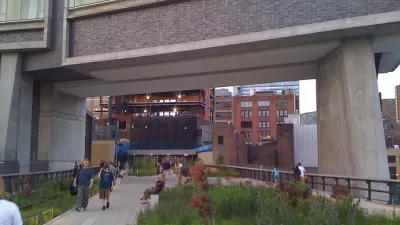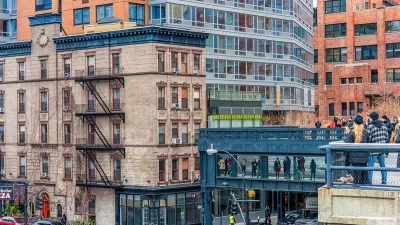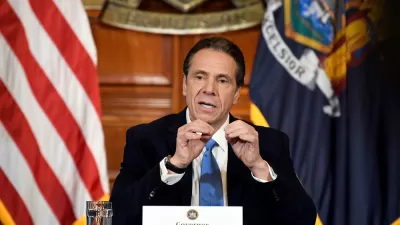One of Manhattan's most popular tourist attractions, the linear, elevated urban park that existed as a freight rail line as late as 1980, is also a means of commuting to work - but only for walkers as cycling is prohibited along the High Line.

Calling it the High Line's "best-kept secret", Matt Flegenheimer writes, "With no traffic lights, no cars or bikes (prohibited under park rules) and few tourists during the morning rush, the raised stretch has come to attract commuters — not because it is picturesque, but because it is faster."
Flegenheimer timed the High Line commute to walking the same distance at street level, from Gansevoort St. to West 30th, complete with stair-walking to get to/from the elevated park (though elevators do exist). The High Line won by five minutes.
Some Chelsea residents began commuting almost immediately after the park opened, said Robert Hammond, a co-founder of Friends of the High Line. But the number has accelerated since the introduction of Section Two [in December, 2010], he said, with the pathway extended nearer to Midtown residents who work at Google or other companies in Chelsea Market.
The walkway even attracts commuters from outside the area, serving a multi-modal function.
Jane Potenzo, 63, of Port Washington, N.Y., said she typically walked the High Line to reach Chelsea after taking the Long Island Rail Road to Penn Station, hoping to spot foliage coming into or out of bloom. “It’s the best part of my day,” she said.
Unlike a real highway though, the commuters must share the 'roadway' with joggers, parents pushing strollers, picture-takers, and the queues at the coffee-stations along the route.
FULL STORY: High Line’s Best-Kept Secret: It’s a Fast Commute

Alabama: Trump Terminates Settlements for Black Communities Harmed By Raw Sewage
Trump deemed the landmark civil rights agreement “illegal DEI and environmental justice policy.”

Study: Maui’s Plan to Convert Vacation Rentals to Long-Term Housing Could Cause Nearly $1 Billion Economic Loss
The plan would reduce visitor accommodation by 25% resulting in 1,900 jobs lost.

Planetizen Federal Action Tracker
A weekly monitor of how Trump’s orders and actions are impacting planners and planning in America.

Wind Energy on the Rise Despite Federal Policy Reversal
The Trump administration is revoking federal support for renewable energy, but demand for new projects continues unabated.

Passengers Flock to Caltrain After Electrification
The new electric trains are running faster and more reliably, leading to strong ridership growth on the Bay Area rail system.

Texas Churches Rally Behind ‘Yes in God’s Back Yard’ Legislation
Religious leaders want the state to reduce zoning regulations to streamline leasing church-owned land to housing developers.
Urban Design for Planners 1: Software Tools
This six-course series explores essential urban design concepts using open source software and equips planners with the tools they need to participate fully in the urban design process.
Planning for Universal Design
Learn the tools for implementing Universal Design in planning regulations.
Caltrans
Smith Gee Studio
Institute for Housing and Urban Development Studies (IHS)
City of Grandview
Harvard GSD Executive Education
Toledo-Lucas County Plan Commissions
Salt Lake City
NYU Wagner Graduate School of Public Service





























